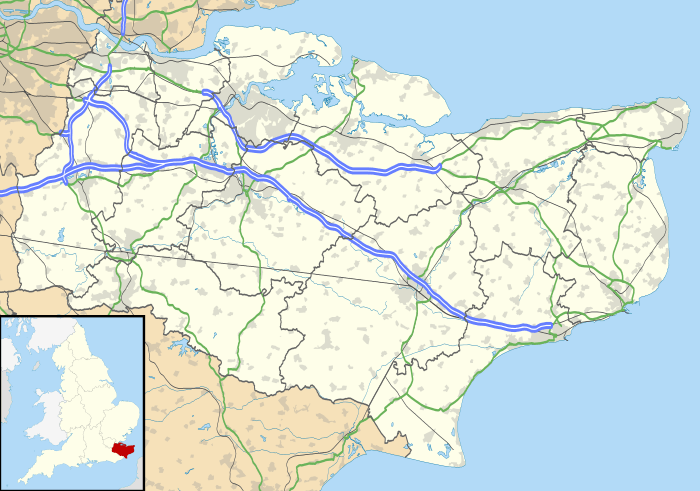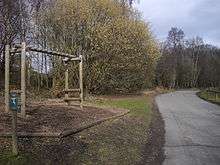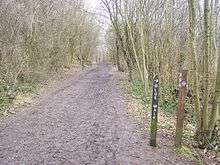Trosley Country Park
Trosley Country Park is in Trottiscliffe, near Vigo, in Kent, England. Once part of a large woodland estate then after many changes, it was passed to Kent County Council, who turned it into a large country park.
| Trosley Country Park | |
|---|---|
 Visitor Centre in Trosley Country Park | |
 Trosley Country Park shown within Kent | |
| OS grid | TQ633610 |
| Coordinates | 51°19′31″N 0°20′30″E |
| Area | 170 acres (690,000 m2) |
| Created | 1976 |
| Operated by | Kent County Council, |
| Status | Open 7 days a week, dawn until dusk |
| Website | Kent City Council: Trosley Country Park |
History
The country park was once part of the Trosley Towers Estate.[1]
In 1870, Sir Sydney Waterlow, 1st Baronet bought large areas of land including the village of Fairseat (near Stansted, Kent; 1 mile [1.6 km] west of Trottiscliffe), a major section of Stanstead as well as other pieces of land from Wrotham (2 miles [3.2 km] south of Trottiscliffe) to Meopham (2 miles [3.2 km] north of Trotiscliffe). The parts of the estate were linked by a small bridge bearing the family crest over Trottiscliffe Road (which is still in evidence today).
In 1887, he built Trosley Towers on the crest of the escarpment on the North Downs, to the east of Trottiscliffe Road. Two drives approached the house, and it was surrounded by wooded grounds. Later, other private drives were constructed, including Hamilton Drive which still survives within the Trosley Country Park and runs from the site of the old house to Commority Road.

When Sir Sidney died in 1906, the estate passed to his son Philip (Philip Hickson Waterlow, 2nd Baronet (1847–1931), who also became a sir,[2]).[3] When Philip died in 1931, the estate was sold off. Some of the houses (of the estate) were bought by tenants, one of these was Pilgrims House,[4] with 6 acres (24,000 m2) of land, at the bottom of Trottiscliffe Road, which went for £600. Trosley Towers and the woodlands around it were sold to 'Mr E. E. Shahmoon' in 1935, this was also the time of the chalet building.
In 1936, Mr Shahmoon had Trosley Towers demolished and had Hamilton Lodge built along with adjoining stables. One story suggests that the Lodge and stables were built to accommodate the Shah of Persia and his racehorses on his visits to England.
The whole area was still owned by Mr Shahmoon when it was taken over by the army in 1942 during World War II and Hamilton Lodge was to be the HQ of the Army Brigade that was stationed here.[5]
The manor house in the estate was later demolished.[6]
The 170-acre (690,000 m2) park was opened in 1976 by Kent County Council.
In 2004, an amenity block (with a public toilet facility, offices and store area) was built within the park. It had a sweet chestnut (Castanea sativa) timber cladding from the local trees in the park. Also built with a sedum roof and rainwater drainage system recycled into the toilet flushing systems. The building also won the Public Building category of the 2005 Kent Design Awards.[7]
Ecology
It is situated on the North Downs and the chalk grassland slopes of the park are a Site of Special Scientific Interest. These slopes were formerly used as grazing for farm animals, but were left to naturalise after the farms moved to the lower and more productive wealdland pastures. After the park was formed, these grasslands were cleared of scrub to allow the rare chalk land plants and animals to re-establish including the musk orchid, and chalkhill blue butterfly. Other meadow insects found include the dark green fritillary.
Recreation

The park has various circular trails around the site, within Downs Wood, Great Wood and Butchers Wood. Three main trails are marked. The 'Red Route' is 2.5 miles (4.0 km) of fairly flat terrain that uses North Downs Way.The 'Yellow Route' is a 1.5-mile (2.4 km) trail that uses some of the Red Route but is an easier, shorter trail. The 'Blue Route' is 2 miles (3.2 km) long, and involves more challenging terrain, with steep hills and climbs. It also passes Little Pell (wood) Great Pell Field (meadow).
The North Downs Way leads via a bridleway through the Country Park on its way from Wrotham to Upper Halling.[8]
An 'Adventurous Pub Walk' of 8.5 miles (13.7 km) starts in the park and leads to Ryarsh and Addington, before returning to the park.[9] The Coldrum Trail also starts in the country park and leads to the Coldrum Stones, before returning to the park.[1]
Location
Situated off Junction 2 of the M20 motorway, the park is located off the A227 between Meopham and Wrotham.
References
- "Trosley Country Park". www.kent.gov.uk. Retrieved 2016-05-04.
- "Waterlow, Sir Sydney Philip (1878-1944) Knight, diplomat". nationalarchives.gov.uk. Retrieved 2 March 2017.
- "Sir Philip Hickson Waterlow, 2nd Bt". npg.org.uk. Retrieved 2 March 2017.
- Anstiss, David. "Pilgrim's House". www.geograph.org.uk. Retrieved 2016-05-04.
- "Historyof Vigo". www.vigo-kent.org. Retrieved 2016-05-04.
- "Trosley Towers". England's Lost Country Houses. Archived from the original on 2009-03-29.
- "Country park amenity block Trosley Country Park, Kent". www.ecolibriumsolutions.co.uk. 2005. Retrieved 24 December 2013.
- Curtis, Neil; Walker, Jim (2002). North Downs Way. London: Arum Press Ltd. p. 85. ISBN 978-1845132729.
- Easterbrook, Michael. Adventurous Pub Walks in Kent. London: Countryside Books. p. 85. ISBN 978-1-85306-835-5.